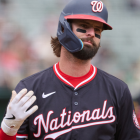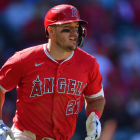The defending World Series champion Boston Red Sox will not have a chance to defend their crown in October. The Red Sox were eliminated from postseason contention Friday, marking the fifth time in the last seven years the defending champion failed to qualify for the postseason the following year. The 1998-2000 Yankees are still baseball's last back-to-back champs.
"Disappointed. It wasn't a great season. We're going to learn from that and we're going to be better. That's the bottom line," manager Alex Cora told reporters, including Pete Abraham of the Boston Globe. "We were very inconsistent from the get-go. We just carried (it) over throughout the season. We never put one of those stretches that we knew that we could put. Other teams were better -- New York and Tampa in our division. They did an outstanding job. Head-to-head they took advantage of it."
Oddly enough, the Red Sox missed the postseason despite having three players who could finish in the top 10-15 of the MVP voting in Mookie Betts, Xander Bogaerts, and Rafael Devers. The bullpen had some memorable hiccups, but mostly, the Red Sox are going home because their rotation was inconsistent at best and straight up bad at worst. Their rotation ranks:
- ERA: 4.87 (20th in MLB)
- WHIP: 1.37 (20th)
- WAR: 10.7 (14th)
Lefty Eduardo Rodriguez had a long-awaited breakout season in 2019. The team's other four primary starters -- Nathan Eovaldi, Rick Porcello, David Price, and Chris Sale -- combined for a 4.99 ERA in 479 2/3 innings. Porcello and Sale had the worst seasons of their careers, and Eovaldi, Price, and Sale all missed long stretches of time with injuries.
There are no shortage of possible reasons explaining the rotation's struggles, with the World Series hangover chief among. It's not just that Boston's starters threw a lot of innings and pitched deep into October last year, it's that they also had a shorter offseason to recover as well. They aren't the first team to see their starters stumble one year after a deep postseason run.
Given the talent on the roster, it's easy to look at the Red Sox and believe they will regroup over the winter and be right back in the postseason mix next season. Betts, Bogaerts, and Devers are as good an offensive core as there is in the game and Price and Sale could bounce back with good health and an offseason to rest and reset. Boston is not short on talent. That's for sure.
At the same time, the Red Sox have hit an organizational crossroads, and they will have to make several significant decisions with long-term impact this winter.
Who replaces Dombrowski?
Earlier this month the Red Sox parted ways with president of baseball operations Dave Dombrowski, supposedly because he clashed with ownership about spending and team-building process. Dombrowski joined the Red Sox in 2015 and did what he always does: spend money, trade prospects, and win a ton of games. Boston won three straight AL East titles from 2016-18.
In the interim, the Red Sox have replaced Dombrowski with a four-person decision-making monster that includes senior vice president of minor and major league operations Raquel Ferreira and assistant general managers Brian O'Halloran, Eddie Romero, and Zack Scott. Ferreira is now the highest-ranking woman in an MLB front office.
Here is a not-at-all complete list of candidates to replace Dombrowski. It should be noted Diamondbacks GM Mike Hazen, who worked under Dombrowski with Boston, recently signed a contract extension to remain in Arizona, so he's no longer a candidate. There are of course countless other qualified candidates in the game who the Red Sox will undoubtedly consider.
The hunch here is the Red Sox want to scale back spending -- they've had baseball's highest payroll the last two years -- and build more from within going forward, without tearing it all down and rebuilding. That's not easy! And the fact Dombrowski was let go one year after a World Series championship and Ben Cherington two years after a title suggests patience is not a virtue in Boston.
Ownership will set the direction for the Red Sox going forward and Dombrowski's replacement will be tasked with leading the team down that path. It's a very desirable job (great city, historic park, talented young players, top of the league payroll, etc.) but it could also be a very challenging job. Whoever replaces Dombrowski will have their hands full.
What happens with Betts?

Betts is about to enter his final season of team control. He'll likely earn a record arbitration salary in 2020 (upwards of $30 million) and he's declined massive contract extension offers in recent years (reportedly seven years and $200 million in 2017). Betts has made it no secret he will not sell himself short when it comes to his next contract.
"I love it here in Boston. It's a great spot. I've definitely grown to love going up north in the cold," Betts told reporters, including Alex Speier of the Boston Globe, back in March. "... That doesn't mean I want to sell myself short of my value."
There is already speculation that the Red Sox could trade Betts this winter. Realistically, they have three options:
- Keep him and let him test free agency next offseason.
- Keep him and sign him to a massive extension.
- Trade him and let some other team worry about his next contract.
Option No. 1 feels like a non-option. You can't let a player as good and as popular as Betts leave as a free agent and get nothing but a dinky draft pick out of it. Option No. 2 should be what happens. Betts turns only 27 in October and the Red Sox should want him in their uniform as long as possible. They can afford a $300 million-plus contract. Don't believe it if they tell you they can't.
Option No. 3 is the most juicy option. What can Betts fetch on the trade market? On one hand, it should be a massive package with multiple young players. He can swing the balance of power in a division race. On the other hand, other teams have to assume they are getting one year of Betts given his apparent commitment to free agency. It's hard to expect him to sign an extension right now.
What teams could have interest in Betts? Well, geez, pretty much all of them, especially contenders. The Angels, Braves, Cubs, Indians, Mets, Nationals, and Phillies all jump to mind as possibilities. Is there a Betts for Noah Syndergaard framework that makes sense? What about Betts for some of those young arms in Atlanta (Ian Anderson, Bryse Wilson, Kyle Wright, etc.)?
It feels like the Red Sox's decision with Betts will tell us everything we need to know about their outlook moving forward. If they trade him, they're probably taking a step back to reload with young players. If they extend him, they we'll know Boston is all-in on this group and considers 2019 a bump in the road, not the beginning of the end for this core.
How do the Red Sox get better?
Whoever the Red Sox bring in to replace Dombrowski -- Romero is considered the top internal candidate but the club is expected to conduct a full search for a new baseball operations chief -- will inherit a talented roster but also some major questions beyond Betts. Specifically, how do the Red Sox get better with a sky high payroll and a farm system that isn't brimming with prospects?
The Red Sox have a $242 million payroll this season for luxury tax purposes, according to Cot's Baseball Contracts, the highest in baseball. They had the highest payroll last year as well. It's one thing to have the game's highest payroll and win the World Series. It's another to have the highest payroll and miss the postseason. That can get people fired.
Here are the significant contracts the Red Sox have coming off the books this winter:
- Rick Porcello: $20.625 million
- Pablo Sandoval: $18.445 million
- Andrew Cashner: $8 million
- Mitch Moreland: $6.5 million
- Steve Pearce: $6.25 million
- Brock Holt: $3.575 million
Yes, the Red Sox were still paying Sandoval despite releasing him in July 2017. His contract still counted against their luxury tax payroll, but that goes away after the season. Those six players will free up $63.395 million in luxury tax payroll space. That's a lot!
Much of that money is already accounted for, however. Thanks to the contract extensions they signed earlier this year, Sale's luxury tax number goes from $15 million this year to $25.6 million next year, and Bogaerts goes from $12 million to $20 million. Betts, Rodriguez, Jackie Bradley Jr., and Andrew Benintendi are among those due arbitration raises.
The luxury tax threshold will be $208 million next year and it's unclear whether ownership, after two years of getting slammed with penalties, wants to get under the threshold similar to the Dodgers and Yankees last year. If that is the case, the Red Sox might not be able to spend much of that $63.395 million after accounting for the upcoming raises.
The Sale and Price contracts are essentially unmovable right now given their injuries, ditto Eovaldi. J.D. Martinez could opt out of his contract following this season and free up $60 million over the next three years, but a) I don't expect Martinez to opt out, and b) that would leave Boston short a very dangerous middle of the order bat. What's good for payroll is bad for the offense.
Furthermore, the Red Sox don't have a robust farm system. It is improved since last year, for sure -- Michael Chavis and Darwinzon Hernandez gave Boston a nice shot in the arm when they were called up earlier this year -- but it is still among the bottom half of the league. Baseball America ranked it the 22nd best system in the game in August:
A great Red Sox farm system had turned into a very thin farm system over the last couple of years after successful graduations and shrewd trades to build a World Series winner. It's back on the rise, however, thanks to productive youngsters like Triston Casas, Bryan Mata and Jarren Duran.
The Red Sox may not have the pieces to swing a significant trade this winter and they may not have much money to spend either, in which case making upgrades could be a challenge. One suggestion: trade Bradley. He is one year away from free agency and is so good defensively that he has value despite inconsistent offense. Trading Bradley and re-signing Betts seems like the way to go.
Trading Bradley frees up some cash -- he'll make roughly $12 million through arbitration in 2020 -- and adds to the system. Boston can shift Benintendi to center field and sign a stopgap left fielder like, say, Corey Dickerson or Hunter Pence. If not Bradley, then trading Benintendi, who did not take the step forward I (and surely many others) expected this year, could be on the table.
Point is, a roster shakeup may be coming. How that happens with a improved but still not great farm system and potentially limited payroll flexibility is anyone's guess. Ownership being willing to exceed the luxury tax payroll next year would go a long way to helping the Red Sox return to contention. The core is still very good. Maximize this window while you can, you know?
A year ago at this time the Red Sox were an unstoppable juggernaut that ripped through two 100-win teams en route to a World Series championship. This year they're a team at a crossroads. They're looking for a new baseball operations head and have to make a long-term decision with their best player. This will be Boston's most important offseason in quite some time.






















